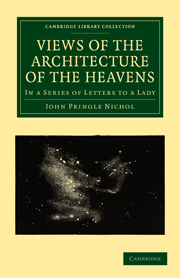Book contents
- Frontmatter
- Contents
- PLATES
- PART I THE FORM OF THE EXISTING UNIVERSE
- LETTER I General Considerations on the System of the Universe—Shape of our Firmament
- LETTER II The power and reach of Telescopes
- LETTER III Aspects, Forms, and Distances of remote Firmaments
- PART II THE CONSTITUENT MECHANISMS, OR THE PRINCIPLE OF THE VITALITY OF STELLAR ARRANGEMENTS
- PART III THE ORIGIN AND PROBABLE DESTINY OF THE PRESENT FORM OF THE MATERIAL CREATION
- NOTES
- Additions and Corrections
LETTER III - Aspects, Forms, and Distances of remote Firmaments
Published online by Cambridge University Press: 29 August 2010
- Frontmatter
- Contents
- PLATES
- PART I THE FORM OF THE EXISTING UNIVERSE
- LETTER I General Considerations on the System of the Universe—Shape of our Firmament
- LETTER II The power and reach of Telescopes
- LETTER III Aspects, Forms, and Distances of remote Firmaments
- PART II THE CONSTITUENT MECHANISMS, OR THE PRINCIPLE OF THE VITALITY OF STELLAR ARRANGEMENTS
- PART III THE ORIGIN AND PROBABLE DESTINY OF THE PRESENT FORM OF THE MATERIAL CREATION
- NOTES
- Additions and Corrections
Summary
We resume our progress. The fact has been already established of the existence of clusters or firmaments, distinct from ours, sustaining an independent position, as individual constituents of creation. Let us now go forth into infinity among these firmaments, and ascertain their character.
The number of such masses is very great. In the northern hemisphere, after making all allowances, those, whose places are fixed, cannot be fewer than between one and two thousand; and you will have a good idea how plentifully they are distributed, by remarking that this is at least equal to the whole number of stars which the naked eye perceives in any ordinary night. These clusters, the general aspects of which I am now to describe to you, have very various appearances to the telescope. In many of them, individual stars are distinctly defined. As they become more remote, the distances or intervals between the stars diminish, the light also growing fainter ; in their faintest stellar aspect, they may be compared to a handful of fine sparkling sand, or, as it is aptly termed, star-dust; and beyond this we see no stars, but only a streak or patch of milky light, like the unresolved portions of our own surrounding zone. This is the state in which they are more properly called Nebulæ, and in which there is risk of confounding them with a singular substance not partaking of the nature of stars, but very common in our firmament.
- Type
- Chapter
- Information
- Views of the Architecture of the HeavensIn a Series of Letters to a Lady, pp. 47 - 60Publisher: Cambridge University PressPrint publication year: 2009First published in: 1837



